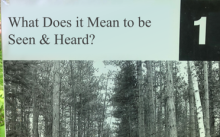You are here
New Grant: Seeing and Hearing Indigenous Voices on the Land

A team of Harvard Forest scientists, Nipmuc leaders, Indigenous students, and educators has received a Culture Lab Innovation Fund grant to amplify the voices of local Indigenous communities and to enhance a sense of belonging for all Indigenous community members at Harvard. Led by Nipmuc leaders and Harvard Forest postdoc S. Joseph Tumber-Dávila, To Be Seen: Acknolwedging Indigneous Land in Green Spaces will build upon collaborative efforts between Nipmuc leaders and Harvard Forest, whose 4,000-acre campus occupies the unceded home territory of the Nipmuc people.
The project will tell stories about science, history, and land stewardship that are not bound by colonial fences and walls. New trail signs will acknowledge the vitality of Nipmuc stewardship of the land and ask the viewer to interrogate their own role in recognizing and amplifying the Nipmuc voice in future land stewardship decision-making in the region. The Harvard Forest research team is aware that this is only a small step towards righting past wrongs. "We know that the real work of decolonization is not accomplished by signs," says Clarisse Hart, Director of Outreach and Education, "It's accomplished by the willingness to engage in questions which will be the center of our signs."
The questions will ask, "What does it mean to be here on the land? What does it mean to be seen?"
The new trail signage will be developed collaboratively by Nipmuc community members, Harvard Forest staff, and student interns over the coming academic year, and unveiled on the public trail in time for a communty discussion event in the spring of 2023.

